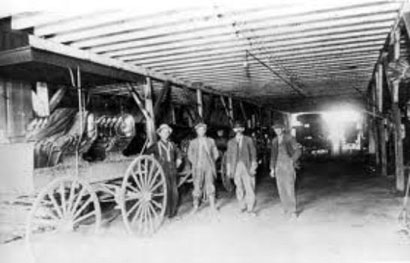|
The
business of the blacksmiths flourished when horses were the chief means
of transportation, when the tires of buggies and wagons needed frequent
setting, and when broken implements required repair at the forge. As
well as William McDonald, McNiven and W. Alex Rogers, each early set up
their blacksmith shops, McNiven near the south end of East Railway
Street, and Rogers on Ash Street between the Butchart hardware store
and the school.
School children passing that blacksmith shop each day came to connect
it in their minds with their school life. They stood at the door to
watch Alex Rogers as he held the horse’s foreleg against his leathern
apron to pare the hoof. They watched him hammer the flat nails that
held the shoe. They saw the red hot plough-shares as Mr. Rogers beat
them upon his anvil and heard the hiss of the steam as he plunged them
into the tub of water beside it. Alex Rogers’ blacksmith shop was a
place of magic to the Hartney youngsters from the years of the school’s
beginning. As he was also the superintendent of the Presbyterian Sunday
school, he and his shop were mysteriously combined in the minds of
Presbyterian children with their first days at Sunday school.
Victor Duchesneau arrived in Hartney about 1901 and set up another
blacksmith business. He enlarged this building in 1904 and started a
carriage and wagon factory. His advertisement at the time announced
that he had “a new eight-horsepower engine, modern band-saw, a joiner,
a fine rip-saw, a hawk-eye trip hammer, a fan blower and a fine grade
emery polishing machine,” and that he could turn out “buggies, wagons,
carriages and all fine lumber work with city style and finish.” The
Duchesneau blacksmith shop shared with that of Alex Rogers the interest
of the school children, for it was situated on the corner of Ash and
Spencer street, directly facing the school.
Adapted from The Mere
Living, page 104
A
Day in the Life of a Blacksmith
For the early settlers, the blacksmith was perhaps the most essential
tradesman. Not only did he make the iron parts for the first farming
implements, he also could repair all iron objects by hammering them by
hand on an anvil.
After heating the iron until white-hot, the blacksmith would then shape
and wield a multitude of objects from it, including carriage bolts and
wheels, iron work, cooking utensils, and most importantly, horseshoes.
Blacksmiths who made horseshoes were called farriers, derived from the
Latin word for iron. At a time when horses were the only means of
transport, the blacksmith was important to not only individual farmers
and travelers, but also to merchants whose businesses depended on
transporting their goods to other places. Also, because they spent much
of their time shoeing horses, blacksmiths gained a considerable amount
of knowledge about equine diseases.
The new industrial output of the late 1800s allowed the smith to
improve his shop. With a small boiler, steam engine, and a system of
overhead shafts, pulleys, and leather belts, the formerly hand operated
shop equipment like the post drill, the blower, and other equipment
could be easily powered. The small belt powered machines like the
Little Giant trip hammer or its blacksmith built counterpart took its
place in many small shops. Later, the “steam” part of the steam driven
leather belt systems were replaced with small gasoline engines or
electric motors. In time, many power hammers were fitted with ther own
electric motors.

A Manitoba blacksmith at work.
|





